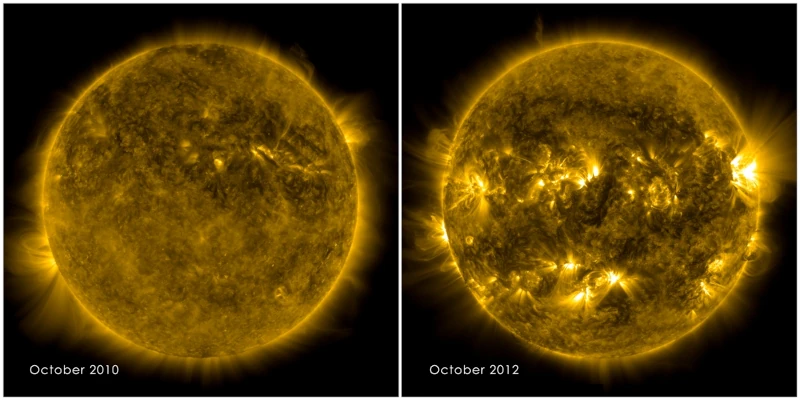
Image description: Comparison of two photographs of the Sun taken with NASA's Solar Dynamics Observatory (SDO) telescope, observing the light emitted by hot plasma, close to a million degrees.
Solar cycles, including periods of solar maximum and minimum, are primarily due to the dynamics of the Sun's magnetic field, which evolves over an approximately 11-year cycle, known as the solar cycle.
The Sun is an active star, and its magnetic field plays a crucial role in solar activity cycles. This magnetic field is generated by a process called the solar dynamo, which is related to the movement of plasma (a state of matter where atoms are ionized) inside the Sun.
The solar dynamo is the mechanism by which the kinetic energy of plasma movements in the Sun is converted into magnetic energy. This process involves two main types of plasma movements:
Inside the Sun, hot plasma rises to the surface, cools down, and then sinks back down, creating convection currents.
The Sun does not rotate like a rigid body; there is differential rotation, meaning the Sun's equator rotates faster than its poles. These movements cause deformations and entanglements in the solar magnetic field.
As the magnetic field strengthens and becomes more complex, it gives rise to sunspots and increased activity. Sunspots are areas where the magnetic field is highly concentrated.
The Sun's magnetic field undergoes a complete reversal approximately every 11 years. The north and south magnetic poles switch, partially resetting the magnetic field. This reversal is a key aspect of the solar cycle and contributes to its periodicity.
Throughout the solar cycle, the Sun's magnetic field evolves due to complex interactions between convective and rotational movements. At certain times, magnetic field lines can group together and form regions where the magnetic field is particularly intense. These regions can give rise to:
Cooler and darker areas on the surface of the Sun where the magnetic field is stronger.
Violent explosions on the surface of the Sun that release a large amount of energy and charged particles into space.
This is the phase of the solar cycle when magnetic activity is at its peak. This is characterized by a large number of sunspots, frequent solar flares, and coronal mass ejections. The Sun's magnetic field is highly complex and disordered during this phase.
This is the period when solar activity is at its lowest. There are few or no sunspots, solar flares are rare, and the magnetic field is simpler and less turbulent.
Throughout the solar cycle, the Sun's magnetic field also undergoes a complete reversal, known as a pole reversal. The Sun's north and south magnetic poles switch, which is a key event in the solar cycle and contributes to the variability of solar activity.
The periods of solar maximum and minimum are thus the result of the complexity and dynamic evolution of the Sun's magnetic field. These variations result from the interaction between the solar plasma and the magnetic field during the solar cycle, periodically altering solar activity. The 11-year duration is the time required for the Sun's magnetic field to shift from a highly structured state to a disordered state and back again.
Solar Maximum: Around 1989
Solar Minimum: Around 1996
Solar Maximum: Around 2000
Solar Minimum: Around 2008
Solar Maximum: Around 2014
Solar Minimum: Around 2008 (to 2010) and 2019
Expected Solar Maximum: Around 2025
Previous Solar Minimum: Around 2019
The average duration of the 11-year solar cycle is the result of a complex balance between the generation and reorganization of the magnetic field by the solar dynamo, the differential rotation of the Sun, and the convective processes inside the star. These mechanisms interact to produce a regular cycle of solar activity, including phases of solar maximum and minimum. The periodicity of this cycle is thus a natural consequence of the Sun's internal magnetic and fluid dynamics.